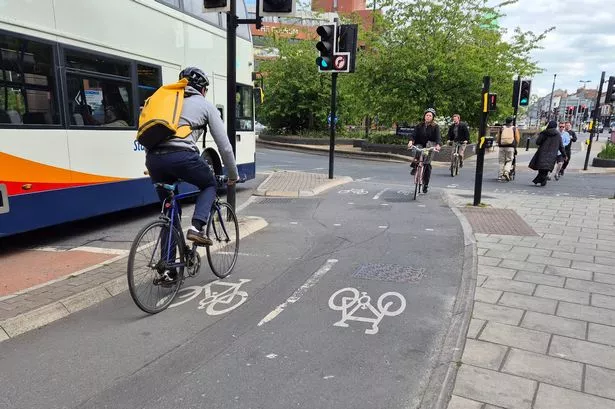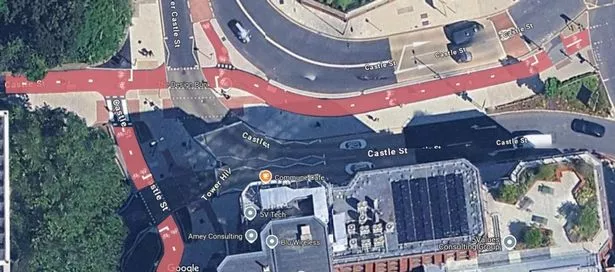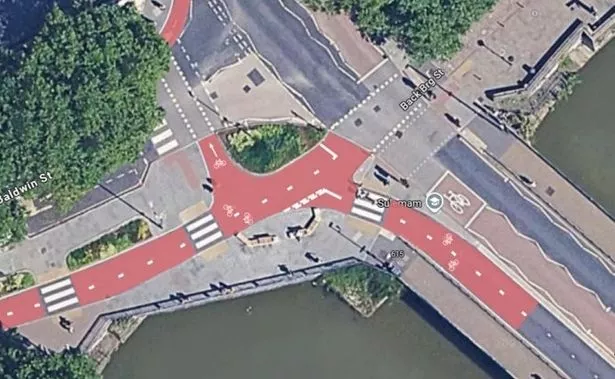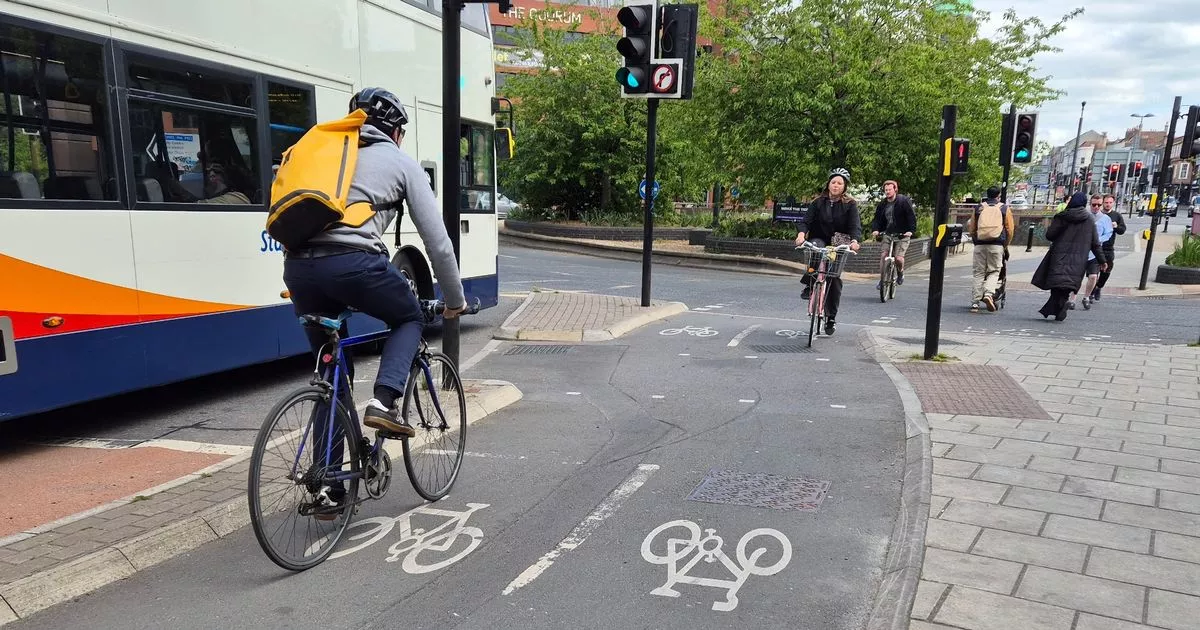A trial will assess if the bright colour helps to make walking and cycling safer The Old Market Gap bike lane could be included in the trial(Image: Alex Seabrook)
The Old Market Gap bike lane could be included in the trial(Image: Alex Seabrook)
Some bike lanes in Bristol could soon be painted red to “reduce conflict” between cyclists and pedestrians as part of a new trial. Many bike paths in the city centre are a similar colour to adjacent pavements, causing confusion among where people should cycle or walk.
Some are notorious for being barely visible or noticeable. Transport bosses at Bristol City Council believe that a different bright colour will prevent pedestrians from straying into cycling lanes without realising, as is common in other European cities.
The trial was welcomed by cycling and walking campaigners, and could be rolled out to many other bike lanes if the results are promising. The plans are likely to be approved by councillors on the transport policy committee on Thursday, May 15.
A committee report said: “There are several benefits to a roll-out of colour on cycle lanes. It has the potential to reinforce the road user hierarchy and improve safety at key conflict points, and would enhance public perception of meaningful progress towards a high quality, densely connected segregated cycle network.
“Unintentional pedestrian use of the cycleway, which can carry fast-moving yet often very quiet bikes, is a key danger of new infrastructure, and can negatively affect the public perception of cycling in Bristol. This is especially important when considering older people, families with young children, or those with more restricted mobility or impairments of sight or hearing.”
The trial could be carried out at either existing bike lanes or ones that will be built soon. On the shortlist are the new bike lanes between the Old Market roundabout and Castle Park, and at Bristol Bridge. Bike lanes which will be built soon include at Union Street, Bedminster Bridges roundabout and Redcliffe roundabout.
 Red bike lanes at the Old Market Gap(Image: Bristol City Council)
Red bike lanes at the Old Market Gap(Image: Bristol City Council)
During the trial, council staff would measure the number of near misses, as well as the number of pedestrians who stray onto bike paths, and vice versa, cyclists who stray onto pavements. Public perceptions of safety and legibility could also be surveyed.
Supporting the plans are the Bristol Cycling Campaign and the Bristol Walking Alliance. In written statements made ahead of the committee meeting, they explained how the new colour scheme would make travelling around the city easier and less stressful.
A spokesperson for the Bristol Cycling Campaign said: “We are very pleased that BCC are considering how to make cycleways easier for cyclists to follow, more visible to motorists to avoid and to help alert pedestrians by distinguishing them using a consistent colour scheme.
“However, it is important to note that adopting a unified cosmetic colour policy will not make disjointed or poorly designed cycle lanes safer to use or encourage more people to cycle. ‘Lipstick on a pig’ comes to mind.
“Coloured surfacing helps drivers see where the cycle lane is and makes it easier for cyclists to follow them at intersections, and especially at potential conflict zones. Evidence shows that it can help to reduce the level of vehicle encroachment and speeding, increase the propensity of drivers to yield the right of way to cyclists, and deter illegal parking or loading in cycle lanes.”
 Red bike lanes on Bristol Bridge(Image: Bristol City Council)
Red bike lanes on Bristol Bridge(Image: Bristol City Council)
A spokesperson for the Bristol Walking Alliance added: “There is the desire to improve the experience for pedestrians and cyclists in the Centre where cycle lanes are indistinct and lead to conflict. Many pedestrians, particularly those who have mobility, cognitive, visual or hearing impairments, can be afraid to use spaces which cyclists may enter and cross unexpectedly.
“Unless cycle lanes are easily distinguishable, pedestrians and cyclists may not be aware of the designated lanes. This may cause pedestrians to stray into cycle lanes and cyclists to stray into pedestrian areas.”
“It has been apparent for some time that the cycle lanes across the Centre in Bristol are a problem. The cycle lanes are not easily distinguishable from the pedestrianised areas, leading to conflict between pedestrians and cyclists.”
Four different colours were weighed up, compared for their strengths and weaknesses. Green would match bike lanes in South Gloucestershire and be less overwhelming for neurodivergent people, due to the “more earthy tone”, but could be hard for people with visual impairments to distinguish between grass, as well as being dull and easy to miss.
Blue would be most effective at night, the preferred colour of local disability experts, and is used in London and Birmingham. But this would be the same colour as the shared path sign, potentially causing confusion. Yellow would be “loud and garish”, look too similar to double yellow lines, and be reflective on sunny days.
Red was chosen as it “stands out effectively”, and is in line with some other bike paths in Bristol which are already painted that colour. However, council staff believe red “could be quite aggressive”, and might cause confusion between bus lanes and bike lanes.
